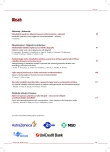Aortic valve sparing operations and reconstruction – from anatomy to the long‑term results
Authors:
J. Vojáček 1; J. Dominik 1; P. Žáček 1; M. Tuna 1; A. Mokráček 2; J. Harrer 1
Authors‘ workplace:
Kardiochirurgická klinika Lékařské fakulty UK a FN Hradec Králové, přednosta doc. MUDr. Jan Harrer, CSc.
1; Kardiochirurgické oddělení Nemocnice České Budějovice a. s., přednosta prim. MUDr. Aleš Mokráček, CSc.
2
Published in:
Vnitř Lék 2009; 55(2): 117-122
Category:
Reviews
Overview
The implantation of an artificial heart valve (a mechanical valve or a xenograft valve) involves the risk of serious and life-threatening complications for the patient, such as hemorrhagic complications, thromboembolic complications, the risk of endocarditis, the risk of premature degeneration of the xenograft valve, etc. Preserving the patient’s own aortic valve eliminates or at least significantly reduces the above complications. On the other hand, it brings about the disadvantage of a technically more demanding surgery and the possible risk of reoperation due to failure of the spared aortic valve. The authors present a comprehensive and up-to-date view of the issue of aortic valve sparing surgeries and plastic corrections, beginning with the basics of aortic root anatomy and ending with the indications and principles of cardiosurgical techniques, and long-term results.
Key words:
aortic valve-sparing operations – reconstruction of aortic valve – aortic root surgery
Sources
1. Hammermeister K, Sethi GK, Henderson WG et al. Outcomes 15 years after valve replacement with a mechanical versus a bioprosthetic valve: final report of the Veterans Affairs randomized trial. J Am Coll Cardiol 2000; 36 : 1152–1158.
2. Popelová J, Benešová M, Brtko M et al. Doporučené postupy pro diagnostiku a léčbu chlopenních srdečních vad v dospělosti. Cor Vasa 2007; 49 : 7–8.
3. Vahanian A, Baumgartner H, Bax J et al. Guidelines on the management of valvular heart disease: The Task Force on the Management of Valvular Heart Disease of the European Society of Cardiology. Eur Heart J 2007; 28 : 230–268.
4. Bonow RO, Carabello BA, Chatterjee K et al. ACC/AHA 2006 guidelines for the management of patients with valvular heart disease: a report of the American College of Cardiology/American Heart Association Task Force on Practice Guidelines. J Am Coll Cardiol 2006; 48: e1–e148.
5. Thubrikar MJ, Labrosse MR, Zehr KJ et al. Aortic root dilatation may alter the dimensions of the valve leaflets. Eur J Cardiothorac Surg 2005; 28 : 850–855.
6. Davies R et al. Novel Measurement of Relative Aortic Size Predicts Rupture of Thoracic Aortic Aneurysma. Ann Thorac Surg 2006; 81 : 169–177.
7. Aicher D, Langer F, Adam O et al. Cusp repair in aortic valve reconstruction: does the technique affect stability? J Thorac Cardiovasc Surg 2007; 134 : 1533–1538.
8. Haydar H, Ho G, Hovaguimian H et al. Valve repair for aortic insufficiency: surgical classification and techniques. Eur J Cardio Thorac Surg 1997; 11 : 258–265.
9. Duran C. Aortic valve repair and reconstruction. Oper Tech Cardiac Thorac Surg 1996; 1 : 15–29.
10. Aicher D, Langer F, Lausberg H et al. Aortic root remodeling: ten-year experience with 274 patients. J Thorac Cardiovasc Surg 2007; 134 : 909–915.
11. Casselman FP, Gillinov AM, Akhrass R et al. Intermediate‑term durability of bicuspid aortic valve repair for prolapsing leaflet. Eur J Cardiothorac Surg 1999; 15 : 302–308.
12. El Khoury G, Vanoverschelde JL, Glineur D et al. Repair of bicuspid aortic valves in patients with aortic regurgitation. Circulation 2006; 114 (Suppl 1): I610–I616.
13. Schäfers HJ, Aicher D, Langer F et al. Preservation of the bicuspid aortic valve. Ann Thorac Surg 2007; 83: S740–S745; discussion S785–S790.
14. Nataf P, Lansac E. Dilation of the thoracic aorta: medical and surgical management. Heart 2006; 92 : 1345–1352.
15. David TE, Feindel CM, Webb GD et al. Aortic valve preservation in patients with aortic root aneurysm: results of the reimplantation technique. Ann Thorac Surg 2007; 83: S732–S735; discussion S785–S790.
16. Yacoub MH, Gehle P, Chandrasekaran V et al. Late results of a valve-preserving operation in patients with aneurysms of the ascending aorta and root. J Thorac Cardiovasc Surg 1998; 115 : 1080–1090.
17. David TE, Feindel CM, Webb GD et al. Long‑term results of aortic valve-sparing operations for aortic root aneurysm. J Thorac Cardiovasc Surg 2006; 132 : 347–354.
18. Erasmi AW, Sievers HH, Bechtel JF et al. Remodeling or reimplantation for valve-sparing aortic root surgery? Ann Thorac Surg 2007; 83: S752–S756; discussion S785–S790.
19. de Oliveira NC, David TE, Ivanov J et al. Results of surgery for aortic root aneurysm in patients with Marfan syndrome. J Thorac Cardiovasc Surg 2003; 125 : 789–796.
20. Kallenbach K, Baraki H, Khaladj N et al. Aortic valve-sparing operation in Marfan syndrome: what do we know after a decade? Ann Thorac Surg 2007; 83 : 764–S768.
21. Patel ND, Weiss ES, Alejo DE et al. Aortic root operations for Marfan syndrome: a comparison of the Bentall and valve-sparing procedures. Ann Thorac Surg 2008; 85 : 2003–2010.
Labels
Diabetology Endocrinology Internal medicineArticle was published in
Internal Medicine

2009 Issue 2
Most read in this issue
- Superficial thrombophlebitis – diagnostics and treatment
- Guidelines for duplex ultrasound exam of limb veins
- Aortic valve sparing operations and reconstruction – from anatomy to the long‑term results
- The combination of an ACE inhibitor and a calcium channel blocker is an optimal combination for the treatment of hypertension
